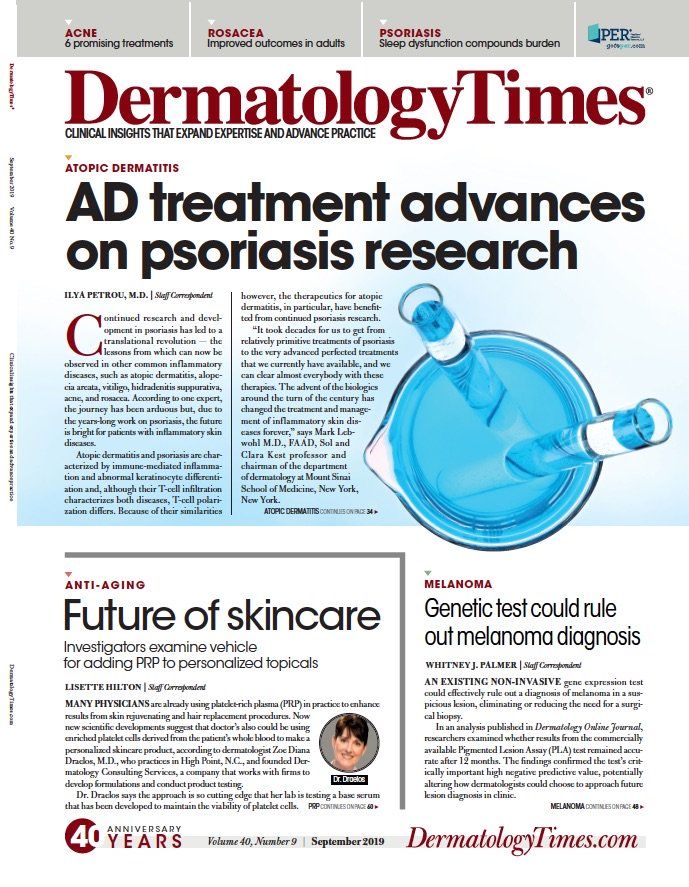- Case-Based Roundtable
- General Dermatology
- Eczema
- Chronic Hand Eczema
- Alopecia
- Aesthetics
- Vitiligo
- COVID-19
- Actinic Keratosis
- Precision Medicine and Biologics
- Rare Disease
- Wound Care
- Rosacea
- Psoriasis
- Psoriatic Arthritis
- Atopic Dermatitis
- Melasma
- NP and PA
- Skin Cancer
- Hidradenitis Suppurativa
- Drug Watch
- Pigmentary Disorders
- Acne
- Pediatric Dermatology
- Practice Management
- Prurigo Nodularis
- Buy-and-Bill
Publication
Article
Dermatology Times
Skincare advice across the generations
To meet the skin's changing needs over various life stages, experts at the Generational Dermatology Symposium held earlier this year suggest being proactive about barrier problems and that moisturization is key to maintaining skin health.
Dr. Gendler

Dr. Alexis

To meet the skin's changing needs over various life stages, experts at the Generational Dermatology Symposium held earlier this year suggest being proactive about barrier problems and moisturization is key to maintaining skin health.
As a baseline, Ellen C. Gendler, M.D., says that one should use the same type of sunscreen from childhood to old age. She is a clinical associate professor of dermatology at New York University Langone Medical Center.
"Not all sunscreens are created equal," she says. "And starting early with a real UVA-blocking sunscreen is very important." She advises against typical American-made chemical sunscreens containing avobenzone, octocrylene, oxybenzone and octinoxate in favor of ingredients from Europe (see Table 1).
Zinc oxide can block a large percentage of UVA, adds Dr. Gendler, but it requires a trade-off between efficacy and elegance.
Millennial Musts
"All millennials should use some form of retinoid," she says, "even a mild one. Retin-A (tretinoin, Ortho Dermatologics) is the only thing that's ever been shown to help prevent the progression of wrinkles and the formation of precancerous keratoses and possibly skin cancer. So when possible, starting prescription strength Retin-A young is very helpful." If that's too irritating, or a woman of childbearing age doesn't want to go on and off it, Dr. Gendler recommends over-the-counter retinoids such as retinol.
Also for 20-somethings, she suggests creams containing DNA repair enzymes, which can reverse the DNA damage that occurs immediately upon sun exposure. However, identifying these ingredients can be tough, Dr. Gendler says, because manufacturers often combine extracts of plankton or algae with other ingredients and give the resulting formulation a proprietary name. Photosomes (Barnet), for example, are light-activated DNA repair enzymes for daytime use. DNA repair enzymes for nighttime use include UV-specific endonucleases and 8-oxoguanine glycosylase (OGG1), says Dr. Gendler.
European sunscreens sometimes contain DNA repair enzymes, she adds. Examples include Eryfotona Actinica 50 (Isdin), which is also available stateside.
The 30s
According to Dr. Gendler, "The 30s is the right time to start an eye cream." To target sagging skin and wrinkling, these products should also contain DNA repair enzymes - particularly those that support elastin, says Dr. Gendler. Additional eye cream ingredients aim to lighten under-eye pigmentation. "Whether or not they actually do is another issue. But getting into the habit of using a lightweight eye cream is a wise introduction to the world of skincare."
For women in their 30s who are through having children, she recommended Premarin (Pfizer) cream under the eyes. "Topical estrogens have been shown to keep skin thick."1-3
The 40s
In the 40s, patients may exhibit pigmentary changes that require bleaching agents. "These can range from something powerful like hydroquinone to things that are the less powerful like kojic acid, topical tranexamic acid or arbutase," Dr. Gendler says.
The 40s are also the decade when women typically start noticing neck laxity. It is unknown whether neck creams really do much, she says, "But applying a gentle retinoid to the neck will certainly help you maintain the integrity of your skin there."
Additionally, Dr. Gendler suggests maintenance treatments in the 40s. "It doesn't have to be anything deep. But chemical peels are helpful. Clear + Brilliant, which is a gentle form of a Fraxel laser (both by Solta Medical), can be very helpful."
The 50s and Beyond
In the 50s and 60s, she advises using hand creams to reduce sun damage that becomes evident as skin starts to thin. She particularly likes Restorsea Repairing Hand Treatment (Restorsea, LLC), which is derived from a salmon enzyme. Patients in their 50s and 60s might also need to consider more aggressive procedures such as deeper laser treatments to address pigmentation, she says.
Andrew F. Alexis, M.D., adds, "The barrier function of our epidermis changes with different stages of life, from infancy to the opposite extreme of age." He is professor and chair, Department of Dermatology, Mount Sinai St. Luke's and Mount Sinai West in New York.
As people reach their 70s, he says, the stratum corneum (SC) begins to lose lipids and acidity. These changes reduce the desquamation rate of keratinocytes, leading to scaling and dryness. Moisturizing cleansers and appropriate moisturizers can help to mitigate these changes, he says.
"Cleansing is a delicate balance between removing what we don't want and leaving behind what we do want." While it's important to remove pathogens and debris from the skin's surface, he explains, soaps remove natural lipids and oils, resulting in dryness.
Traditional soaps are made of long-chain fatty acid alkali salts with a high pH. These salts disrupt the skin barrier by stripping many of its natural lipids and increasing skin-surface pH, which causes further barrier disruption. To better preserve natural pH, says Dr. Alexis, synthetic detergents now used in moisturizing body washes and soaps contain milder surfactants that are less disruptive the skin barrier.
The traditional, commonly used surfactant sodium lauryl ether sulfate (SLES) is more likely to dry out lipids and alkalinize the skin than are newer, milder surfactants such as sodium cocoyl isethionate (SCI) and glycinate, Dr. Alexis says.
Skincare Education &Advice
Key moisturizers used in sophisticated cleansers and body washes include humectants, such as glycerin, which draw water outward to the SC. Occlusives such as petrolatum and mineral oil prevent evaporation through the SC. These ingredients can compensate for the lipids removed during the cleansing process, says Dr. Alexis.
"Then after the shower, what you moisturize with is important," according to Dr. Alexis. These products should also include occlusives and humectants, he says, and people should apply them immediately after bathing or showering, while skin is still moist, to trap water before it evaporates.
Aside from normal skin, adds Dr. Alexis, studies show that daily moisturization can be an important adjunct in managing atopic dermatitis. In one study, median time to relapse among patients who used daily moisturizer was 180 days, versus 30 days for those who did not.4
Convincing patients to heed sound skincare advice can prove challenging. "There's sometimes resistance when patients are loyal to specific brands or home remedies and skincare practices that they've been told in their communities are helpful," says Dr. Alexis.
A classic example involves bar soap, which leaves dry, tight skin that patients may associate with cleanliness. "To shift from that to a body wash that leaves the skin with some sheen and smoothness because of its moisturizing properties takes some getting used to," he says. Another example is black soap, a "natural" product made from the ash of African plants such as plantain skins and palm tree leaves. Dr. Alexis says black soap is popular among West Africans and, increasingly, African-Americans. While it can provide antimicrobial effects, he says, it can also leave skin very dry.
Another traditional practice involves using coconut oil as a moisturizer. However, according to Dr. Alexis, single-ingredient moisturizers likely won't work as well as those formulated with humectants and occlusive ingredients.
The education process often involves having patients try free moisturizer samples in the office.
"When it comes to cleansers, giving samples for them to try at home goes a long way. Then they see the effect for themselves," Dr. Alexis says.
Disclosures:
Dr. Alexis is a consultant and/or advisory board member for Unilever, L'Oreal and Beiersdorf. Dr. Gendler reports no relevant financial interests.
References:
- Rzepecki AK, Murase JE, Juran R, Fabi SG, McLellan BN. Estrogen-deficient skin: The role of topical therapy. Int J Womens Dermatol. 2019;5:85-90.
- Son ED, Lee JY, Lee S, et al. Topical application of 17beta-estradiol increases extracellular matrix protein synthesis by stimulating tgf-Beta signaling in aged human skin in vivo. J Invest Dermatol. 2005;124:1149-1161.
- Creidi P, Faivre B, Agache P, Richard E, Haudiquet V, Sauvanet JP. Effect of a conjugated oestrogen (Premarin) cream on ageing facial skin. A comparative study with a placebo cream. Maturitas. 1994;19:211-223.
- Wirén K, Nohlgård C, Nyberg F, et al. Treatment with a barrier-strengthening moisturizing cream delays relapse of atopic dermatitis: a prospective and randomized controlled clinical trial. J Eur Acad Dermatol Venereol. 2009;23:1267-1272.
MEETING
Andrew Alexis MD. "Generational Skin Barrier Dynamics," Generational Dermatology Palm Springs Symposium. March 22, 2019.
Ellen Gendler MD. "Generational Skincare: What Decade Which Products?" Generational Dermatology Palm Springs Symposium . March 22, 2019.






